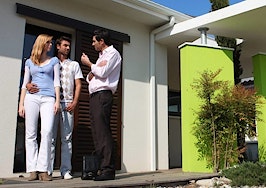Have you ever noticed how much selling a home resembles special event production? To get a home on the market and create “a grand entry” requires the same level of planning and advance work that a major gala or a formal wedding does.
Nobody would expect you to pull off one of those events with two week’s notice. So if you want to create a show-stopper opening for a new listing, insist on getting the planning and prep work underway as early as possible.
And don’t let clients who want the most money and the fastest sale talk you out of doing what you know is required to create that “wow” moment for prospective buyers seeing your seller’s home for the first time!
With adequate prep time, here are the steps to take to achieve a show-stopping first impression.
1. Set the right price

Credit: Andy Dean Photography/Shutterstock
As soon as you know your seller will be putting the home on the market, pull comps for both the home and the area to establish a current pricing range. Recheck comps at least monthly to monitor the market’s direction for properties of this time and in this area. Calculate a realistic price and resist all pleas to “try” a higher price.
2. Figure out your target market

Credit: Marco Verch “Two darts pinned to the center” | flickr | https://creativecommons.org/licenses/by/2.0/ | (CC BY 2.0)
With your seller — and your stager (but not simultaneously) — discuss the categories of people who are most likely to buy this home. For example, first-time buyers, young families, established families, younger or older couples, singles, people planning to retire, high-level professional singles or couples, etc.
Once you’ve pinpointed your target market (or markets), visualize that target as you tailor your sales messaging, including the staging, the advertising design, copy and placement and how the property is presented online and in other marketing venues.
For example, if you know your target buyer is a busy urban professional and the listing is in a desirable urban area, you might plan some early evening open houses scheduled just after the work day ends.
3. Get the home show-ready

Credit: Iriana Shiyan/Shutterstock
As soon as you have a solid vision of the likely buyer of your listing, do a walk-through — preferably with your stager but without the sellers — to determine needed repairs, changes, subtractions and additions.
You can discuss the recommended changes with the sellers afterward, but spare your stager the inevitable conversation about how much the seller knows about making the place look good.
They don’t.
They know how to make the place look good to them. Unfortunately, they’re not buying. They’re selling. They should leave staging to the professionals.
An aside: If you don’t have a good stager, consider finding one. If a home sits on the market, sellers don’t blame themselves: they blame you.
Because a well-staged home generally sells faster and for a higher price, hiring a stager makes your clients think you’re a genius.
Plus, the best stagers really understand how to create multiple “wow” moments for buyers viewing the property online and in person.
4. Put the sellers to work

Credit: Andy Dean Photography / Shutterstock.com
While the stager is off crafting overall designs and creating the “wow” elements of each room, the clients — with help from your list of home renovators, carpet cleaners, housekeepers, window washers, etc. — can devote themselves to repairing, repainting, retouching and decluttering the property so it is ready to be staged.
5. Make it sparkle

Iriana Shiyan / Shutterstock.com
Finally, ensure that the entire house and yard are cleaned until everything sparkles. Emphasize how important keeping the home at this level of clean is, especially if they plan to live in what will essentially become a model home.
6. Kill the lived-in smell

Joshua Resnick / Shutterstock.com
Make sure the property smells divine. Bowls of lemons, fresh flowers (keep the water fresh) hidden containers of fresh coffee beans, an open box of baking soda in the fridge and dryer sheets in the HVAC vents are some of the best ways to lightly scent a house.
Plug-in air fresheners and sprays are banned.
7. Create an entrance

Elena Elisseeva / Shutterstock.com
Plan to make a great first impression in all the right places: online, curbside and inside. That usually involves highlighting focal points and creating drama.
Good stagers already know this, but confirm with your stager that your goal is for buyers to experience as many “wow” moments as possible, but especially when they:
- first see the property photos online.
- arrive at the entry.
- step through the front door.
8. Create the imagery

Iriana Shiyan / Shutterstock.com
Once the stager has worked his or her magic, you will want the absolute best photographer you can afford to shoot stills and — if the place is at all large or spatial relations are difficult to determine — video.
Online is the new “curb,” and these are the tools that build appeal:
- The photography and copy, including captions, should be specifically aimed at your target audience of buyers. And they should highlight the focal points and dramatic elements of each room. Close-ups may do the trick.
- Demonstrations via video may be required. If you do a visual tour, it needs to move, not just pan in and out on still photos. Narration may or may not be needed depending on the property and how apparent the flow of the home is. If narration is used, the language should appeal to the target buyer, and it should be brief.
- Floor plans are also useful in showing how rooms related to each other. The visuals selected should be the most “wow” photo of each room. (Laundry rooms are the toughest to get a wow from. But if the functionality is amazing, it can be its own kind of wow.)
- Have a friend test a walk-through. When the staging is done (but before the home becomes available for showing to the public) take a trusted friend or colleague to the property, unlock the door and invite him or her to step through first. If the first thing you hear is “Oh, wow!” everything has worked as planned, and you’re home free.
Nicole Solari is owner and managing broker of The Solari Group in Solano and Napa Counties in Northern California. Nicole runs one of the highest producing brokerages in all of Northern California.








